Item 1: Report to Shareholders
 |
| Blue Chip Growth Fund | December 31, 2007 |
The views and opinions in this report were current as of December 31, 2007. They are not guarantees of performance or investment results and should not be taken as investment advice. Investment decisions reflect a variety of factors, and the managers reserve the right to change their views about individual stocks, sectors, and the markets at any time. As a result, the views expressed should not be relied upon as a forecast of the fund’s future investment intent. The report is certified under the Sarbanes-Oxley Act, which requires mutual funds and other public companies to affirm that, to the best of their knowledge, the information in their financial reports is fairly and accurately stated in all material respects.
REPORTS ON THE WEB
Sign up for our E-mail Program, and you can begin to receive updated fund reports and prospectuses online rather than through the mail. Log in to your account at troweprice.com for more information.
Manager’s Letter
Fellow Shareholders
Global stock markets performed well in 2007, but most U.S. equity indexes declined in the second half of the year. A sharp slowdown in housing, related subprime mortgage woes, and rising energy prices created challenges for consumers and ultimately corporate earnings. A sharp reduction in liquidity in certain lending and financial markets was particularly problematic for many financial companies. We certainly do not want to dismiss or sugarcoat the problems facing the market, especially given the difficult start for stocks in 2008. However, we believe that moderating interest rates, reasonable valuations, and continued earnings growth are supportive of favorable investment performance for many large-cap growth stocks.

HIGHLIGHTS
• The Blue Chip Growth Fund posted strong returns for the six months and year ended December 31, 2007, outperforming the S&P 500 Index by a wide margin.
• Our holdings in the information technology, energy, and industrials and business services sectors were the portfolio’s best contributors for the past six months.
• Ultimately, corporate earnings, interest rates, and valuation will be the primary determinants of stock performance.
• We think high-quality, consistent-growth companies appear attractive, and we believe a solid case can be made for investing in large-cap growth stocks.
The fund produced strong absolute and relative returns that outperformed the benchmark S&P 500 Stock Index by a wide margin for the 6- and 12-month periods ended December 31, 2007. The fund also outperformed the style-specific Russell 1000 Growth Index for those periods, but underperformed the Lipper index of large-cap growth funds. (Results for the Advisor and R Class shares were slightly lower, reflecting their higher fee structures.)
The Blue Chip Growth Fund continued to compare favorably relative to its peer group over the longer term. Lipper ranked the fund in the top 28% of its large-cap growth funds universe for the 5- and 10-year periods ended December 31, 2007. (Based on cumulative total return, Lipper ranked the Blue Chip Growth Fund 396 out of 723, 125 out of 515, and 66 out of 239 funds in the large-cap growth funds universe for the 1-, 5-, and 10-year periods ended December 31, 2007, respectively. Past performance cannot guarantee future results.)
MARKET ENVIRONMENT
The current market environment has presented some significant challenges for investors. Weakness in housing and the inability of some subprime mortgage holders to pay their mortgages has led to a sharp increase in delinquencies and ultimately losses for investors in various mortgage-related securities. For example, subprime mortgages were packaged and sold in financial instruments such as collateralized debt obligations (CDOs), which have experienced substantial losses. This contributed to a sharp reduction in liquidity and lending activity, which led to economic slowing. Further deterioration in housing, lending, or loan quality poses additional risks for the economy and financial markets.
Unfortunately, the Federal Reserve’s ability to deal with the mortgage problems and related economic weakness is hampered by inflation concerns due to buoyant energy and commodity prices, as well as the continued weakness in the dollar. However, the evidence emerging in early 2008 suggests that slowing economic growth will probably be a top priority and cause the Federal Reserve to continue to lower rates. A fiscal stimulus package will likely be proposed by President Bush and perhaps Congress. Against that backdrop, investors will be watching to make sure that inflation and the weakness of the dollar do not become more problematic. Ultimately, slowing economic growth and rising productivity could dampen factors such as rising unit labor costs and energy prices that contribute to inflation, making the Fed’s job more manageable.
In our view, corporate earnings, inflation and interest rates, and valuation will be primary drivers of stock performance. Excluding the massive writedowns at financial companies, we believe that corporate earnings should be solid for many companies. Strong growth in Asia, Europe, and an array of international markets could continue to support earnings growth at many multinational companies. Inflation and interest rates could moderate given slowing economic growth. Finally, we believe valuation should not be underestimated as a determinant of future stock performance. Recent volatility has led to sharp declines in many stocks, and valuations are reasonable in our view.
PORTFOLIO REVIEW
Information technology stocks, our largest sector allocation, were the best performers in the second half of 2007 and for the full year. Apple was the fund’s largest contributor during the past six months. The company continued to generate substantial gains, thanks to the launch of several innovative products. While the iPhone appears to have generated the most interest, the iPod touch, which allows wireless downloading of music and has the iPhone touch screen, and the Mac personal computer are generating strong sales. Google, the fund’s largest holding and second-best second-half contributor, rebounded sharply from its August low. In addition to its better than 60% market share in Internet search, the company is also expanding profitably into banner advertising, video, and applications software and security. Microsoft has been a controversial stock because it is viewed as being threatened by Apple and Google. However, recent results were quite strong as its Vista, Office, Sequel Server, Xbox, and Internet-based businesses all performed well. (Please refer to the portfolio of investments for a detailed list of holdings and the amount each represents in the portfolio.)
Among our communications equipment industry holdings, Nokia and Juniper posted strong performances. Nokia is the leading manufacturer of cellular phones and hand-held interactive media devices, and both companies provide networking equipment used in telecommunications. In the software area, Oracle has quietly solidified its dominant position in database software. Electronic Arts has also begun to reassert its leadership position in entertainment software, thanks to new management, which is driving accelerated and more efficient product development. Both stocks performed quite well in the second half of the year.
Energy was the second-best contributing sector in the second half and for the full year. Schlumberger and Smith International are leaders in the energy equipment and services industry, and both generate strong free cash flow and solid return on equity. They are two of our energy analyst’s favorite stocks and have been stellar multiyear performers. Murphy Oil, which has major production coming on line in Malaysia, and ExxonMobil have also been solid performers over time, and both stocks performed well in the second half.
Our industrials and business services stocks provided improved performance in the second half. Foster Wheeler and McDermott International are leaders in the construction and engineering area with significant and growing backlogs to construct power generation, drilling, refining, and nuclear facilities. The companies are well managed and are generating improved margins, earnings, and free cash flow growth that our analyst believes can be sustained for several years. His conviction in these stocks has already resulted in handsome gains for the portfolio. Danaher, a portfolio holding for well over a decade, continued to generate quite impressive earnings and free cash flow growth in 2007. As many industrial companies begin to struggle due to the slowdown in economic growth, Danaher’s durable franchises came to the fore, generating solid earnings and stock gains. In a similar way, General Dynamics’ strong positions in less-cyclical defense businesses, its thriving Gulfstream corporate jet business, and its top-notch management team drove solid free cash flow generation and sector-leading stock performance.
The materials sector is a small part of your fund, but two holdings produced robust gains. Monsanto has been one of our best performers over the last few years. Monsanto has a dominant position in genetically engineered corn, soybean, fruit, and vegetable seeds. The company’s engineered seed is able to increase farmers’ per-acre yield, because it provides increased resistance to disease, insects, or drought. Increased planting in Asia and other areas and additional corn planting for ethanol production were part of the growth story this year. We believe these trends will continue, allowing the company to generate strong growth for several years.
Our metals and mining analyst is still quite keen on the prospects for Freeport-McMoRan Copper & Gold. We added the holding in the first half of 2007 for three main reasons: demand for copper from China is strong and growing, the country has virtually no copper production capabilities, and it is very difficult to substitute other metals for copper. We believe the company will continue to benefit from resilience in copper prices and its large reserves of copper, gold, and molybdenum (used in high-strength steel alloys).
Health care is also worthy of specific mention. Our holdings in pharmaceutical benefits managers continued to generate strong earnings and free cash flow due to the growth in mail order and accelerating use of generics. Express Scripts, Medco, and CVS Caremark were each solid second-half performers. Managed care leaders Aetna and WellPoint also rewarded us for our patient ownership. Both stocks generated good results and strong stock appreciation despite a turbulent fourth-quarter stock market environment. Our biotech holdings produced mixed performance. Gilead Sciences, our largest biotech holding, performed quite well as its dominant HIV management franchise and new products for hepatitis and severe hypertension appear to be on track. However, Genentech and Celgene underperformed the market and the sector during the past six months and hurt our results.
There were a few other noteworthy winners in varied industries. Specifically, household products giant Procter & Gamble generated a strong second-half contribution. Amazon.com was our fourth-largest contributor in the second half, thanks in large part to the success of Amazon Prime and its thriving third-party sales business. Wynn Resorts reported strong results at its Las Vegas and Macau properties, driving the stock sharply higher. We sold a large portion of our holding because we thought the risk/reward characteristics were no longer compelling. However, our recent analysis of the company suggests that its business is quite strong, and we are considering adding back to our position should it correct further.
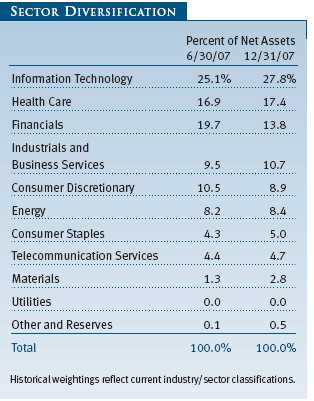
Unfortunately, we had several significant second-half detractors as well. In several cases, we mitigated our losses by taking profits at higher prices. Kohl’s was a disastrous stock and our worst performer. We did not trim much of this retailer on the way down because we felt the company was executing well. The recent difficult environment has certainly played a part in Kohl’s decline. However, we are scrutinizing certain aspects of the company’s operations to make sure that the environment is not masking some missteps or weaknesses we have not identified. Coach was also disappointing, and we have trimmed some of our holding. However, we realize that most consumer stocks have suffered, and this well-managed and highly profitable company could recover. We will scrutinize the latest results of Coach and other consumer companies to determine if we should be adding to the area or cutting our losses.
The travails of the financials group have been well publicized, and although we had some solid second-half winners in the sector, including State Street, Northern Trust, and Charles Schwab, we sold or reduced our exposure to several companies. We were quite concerned about the subprime, structured investment vehicles, and other credit exposures at Citigroup. Fortunately, we sold substantial amounts of this stock over the past few years and eliminated the position in the second half well above its year-end quote. However, it was still the portfolio’s second-largest second-half detractor. We also sold substantial amounts of our positions in Morgan Stanley and UBS. However, we retained a position as several parts of their businesses are performing well, and we believe these stocks could recover relatively quickly. We also eliminated Countrywide Financial. This was one of our better-timed sales, but the stock still was a large detractor to returns for the 6- and 12-month periods. In the insurance industry, American International Group (AIG) hurt our results for six months and the year. Although we reduced our AIG position substantially, we believe that it will slowly recover from the issues that hampered it in the second half.
STRATEGY
Additions to existing holdings such as Laboratory Corporation of America, Freeport-McMoRan, AT&T, and Allergan were significant enough to be included among the 10 largest purchases for the past six months. We also initiated several new positions. McKesson is a leading distributor of pharmaceuticals and other health care products (and also has a health care information systems business). It has performed well after reporting outstanding results. Verisign is the leading Internet domain name registry and also provides Internet security services, including digital certificates used in Internet commerce. Both areas are experiencing solid growth, and this new holding performed well in the second half.
We made several other noteworthy portfolio additions in the past six months. We favor entertainment software and gaming platforms, and Nintendo has a leading position in the area with its DS and Wii platforms. In particular, the Wii system appears to appeal to a wide age range and is attracting many new customers. Costco Wholesale is one of the few retailers that seems to be weathering the current economic slowing well. It has always had a loyal following and strong growth, and management is now generating moderately higher gross margins and solid earnings growth. We are pleased with the company’s solid relative performance.
In addition to Citigroup and AIG, our other large sales included the elimination of Harman International, Legg Mason, Wells Fargo, Home Depot, and LM Ericsson. While Wells Fargo is certainly a well-managed company (with fewer issues than Citigroup, for example), we were still concerned about its large mortgage business and its West Coast housing exposure. The concerns proved to have some validity as the company took a large charge on several of its lending portfolios and experienced a sharp decline in profitability. We became concerned that Home Depot’s turnaround effort would take much longer than planned, partially due to the sharp downturn in housing. LM Ericsson projected shortfalls in revenue and earnings due to pricing pressure and disappointing sales of telecom networking equipment. This was inconsistent with the strong results that our other holdings in the telecom equipment sector (Cisco, Juniper, and Nokia) are generating.
OUTLOOK
Stocks have posted strong gains over the past year but stumbled in the fourth quarter and early in 2008. As we send this report off to the printer in late January, the Federal Open Market Committee has slashed the fed funds rate by 75 basis points (0.75%) to 3.50%. Fed Chairman Ben Bernanke has acknowledged the weakening economic outlook and the “increasing downside risks to growth.”
Although we anticipated a decline in housing activity and housing prices, the correction has been worse than even our fairly pessimistic view. The problems in subprime mortgages have spread and certainly influenced liquidity in broader lending and financial markets. This has contributed to a significant slowing in the domestic economy. The extent of the slowing and whether international economies can decouple from the U.S. (and escape the negative impact) are important considerations. Energy and commodity prices remain uncooperative, and geopolitical events could disturb investors. All of these factors create a more challenging situation for monetary authorities, policymakers, and ultimately investors.
We have tried to carefully weigh these risks. Clearly, the risk of a recession has increased. However, we also believe that the economic slowing we are seeing could dampen some factors that are contributing to inflation concerns. We feel that the prospects for corporate earnings growth at many companies are favorable and that stable or falling interest rates are probable. Valuations are reasonable and have become more supportive due to the recent market decline. Given the challenging economic and investing environment, we continue to believe that high-quality, consistent-growth companies appear attractive. We believe a solid case can be made for investing in large-cap U.S. stocks for the following reasons:
1. Earnings growth remains strong at many high-quality U.S. companies, many of which do not need a robust economy to produce strong profit growth. The recent strong performance of many health care stocks reflects these attributes.
2. The stocks of many consistent-growth companies remain reasonably valued.
3. Many large U.S. multinational growth companies are well diversified by product and geography. This helps them to benefit from any growth occurring in Asia or other faster-growing markets and also provides greater ability to weather external change or difficult conditions in a particular business or region.
4. Many large-cap growth companies have strong balance sheets with record amounts of cash and strong capitalizations. This should allow them to withstand challenges and also to be opportunistic in investing in new products or other businesses.
5. Many of our holdings generate significant free cash flow, and free cash flow margins are at multi-decade highs. Shareholder-oriented management can use this cash to pay dividends (which receive more favorable tax treatment than they did a few years ago), repurchase shares, or make value-added acquisitions.
We continue to strive to enhance returns while managing risk by investing in quality companies with durable, sustainable earnings and cash flow growth. We appreciate your continued confidence in this endeavor.
Respectfully submitted,

Larry J. Puglia
President and chairman of the Investment Advisory Committee
January 15, 2008
The committee chairman has day-to-day responsibility for managing the portfolio and works with committee members in developing and executing the fund’s investment program.
RISKS OF STOCK INVESTING
The fund’s share price can fall because of weakness in the stock markets, a particular industry, or specific holdings. Stock markets can decline for many reasons, including adverse political or economic developments, changes in investor psychology, or heavy institutional selling. The prospects for an industry or company may deteriorate because of a variety of factors, including disappointing earnings or changes in the competitive environment. In addition, the investment manager’s assessment of companies held in a fund may prove incorrect, resulting in losses or poor performance even in rising markets. Growth stocks can be volatile because these companies usually invest a high portion of earnings in their businesses, and earnings disappointments often lead to sharply falling prices. The value approach carries the risk that a security’s intrinsic value may not be recognized for a long time or that the stock may actually be appropriately priced.
GLOSSARY
Dividend yield: The annual dividend of a stock divided by the stock’s price.
Free cash flow: The excess cash a company is generating from its operations that can be taken out of the business for the benefit of shareholders, such as dividends, share repurchases, investments, and acquisitions.
Lipper indexes: Fund benchmarks that consist of a small number (10 to 30) of the largest mutual funds in a particular category as tracked by Lipper Inc.
Price/book ratio: A valuation measure that compares a stock’s market price to its book value, i.e., the company’s net worth divided by the number of outstanding shares.
Price/earnings ratio (P/E): A valuation measure calculated by dividing the price of a stock by its current or projected earnings per share. This ratio gives investors an idea of how much they are paying for current or future earnings power.
Russell 1000 Growth Index: A market capitalization-weighted index of those firms in the Russell 1000 with higher price-to-book ratios and higher forecasted growth values.
S&P 500 Stock Index: An unmanaged index that tracks the stocks of 500 primarily large-cap U.S. companies.
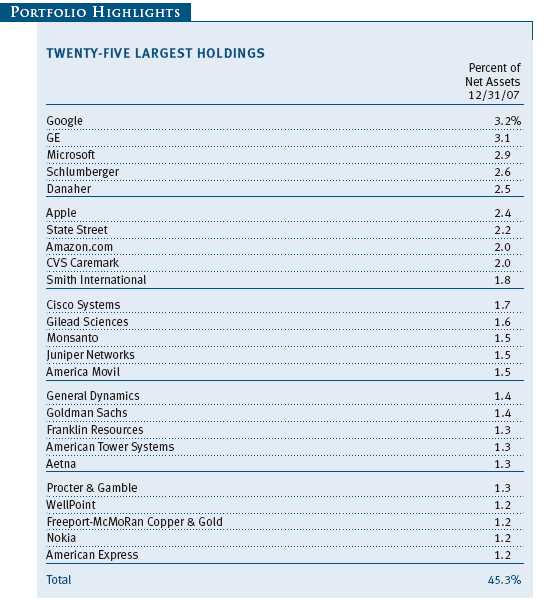
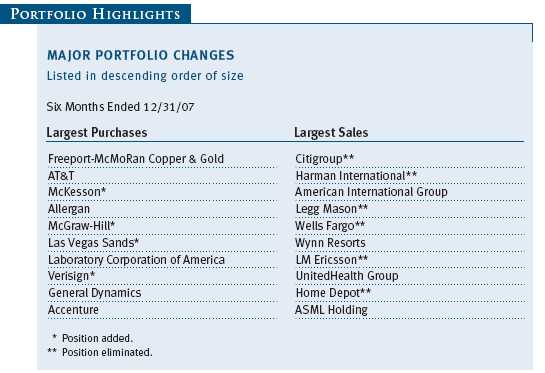
Performance and Expenses
| GROWTH OF $10,000 |
This chart shows the value of a hypothetical $10,000 investment in the fund over the past 10 fiscal year periods or since inception (for funds lacking 10-year records). The result is compared with benchmarks, which may include a broad-based market index and a peer group average or index. Market indexes do not include expenses, which are deducted from fund returns as well as mutual fund averages and indexes.
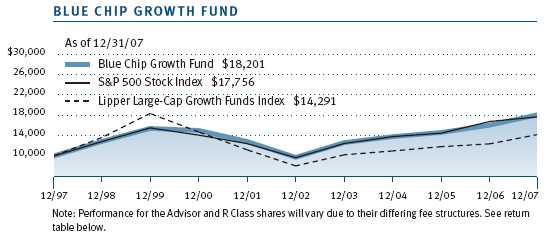
| AVERAGE ANNUAL COMPOUND TOTAL RETURN |
This table shows how the fund would have performed each year if its actual (or cumulative) returns had been earned at a constant rate.
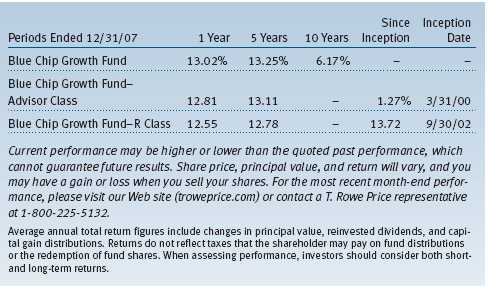

| FUND EXPENSE EXAMPLE |
As a mutual fund shareholder, you may incur two types of costs: (1) transaction costs, such as redemption fees or sales loads, and (2) ongoing costs, including management fees, distribution and service (12b-1) fees, and other fund expenses. The following example is intended to help you understand your ongoing costs (in dollars) of investing in the fund and to compare these costs with the ongoing costs of investing in other mutual funds. The example is based on an investment of $1,000 invested at the beginning of the most recent six-month period and held for the entire period.
Please note that the fund has three share classes: The original share class (“investor class”) charges no distribution and service (12b-1) fee; Advisor Class shares are offered only through unaffiliated brokers and other financial intermediaries and charge a 0.25% 12b-1 fee; R Class shares are available to retirement plans serviced by intermediaries and charge a 0.50% 12b-1 fee. Each share class is presented separately in the table.
Actual Expenses
The first line of the following table (“Actual”) provides information about actual account values and expenses based on the fund’s actual returns. You may use the information in this line, together with your account balance, to estimate the expenses that you paid over the period. Simply divide your account value by $1,000 (for example, an $8,600 account value divided by $1,000 = 8.6), then multiply the result by the number in the first line under the heading “Expenses Paid During Period” to estimate the expenses you paid on your account during this period.
Hypothetical Example for Comparison Purposes
The information on the second line of the table (“Hypothetical”) is based on hypothetical account values and expenses derived from the fund’s actual expense ratio and an assumed 5% per year rate of return before expenses (not the fund’s actual return). You may compare the ongoing costs of investing in the fund with other funds by contrasting this 5% hypothetical example and the 5% hypothetical examples that appear in the shareholder reports of the other funds. The hypothetical account values and expenses may not be used to estimate the actual ending account balance or expenses you paid for the period.
Note: T. Rowe Price charges an annual small-account maintenance fee of $10, generally for accounts with less than $2,000 ($500 for UGMA/UTMA). The fee is waived for any investor whose T. Rowe Price mutual fund accounts total $25,000 or more, accounts employing automatic investing, and IRAs and other retirement plan accounts that utilize a prototype plan sponsored by T. Rowe Price (although a separate custodial or administrative fee may apply to such accounts). This fee is not included in the accompanying table. If you are subject to the fee, keep it in mind when you are estimating the ongoing expenses of investing in the fund and when comparing the expenses of this fund with other funds.
You should also be aware that the expenses shown in the table highlight only your ongoing costs and do not reflect any transaction costs, such as redemption fees or sales loads. Therefore, the second line of the table is useful in comparing ongoing costs only and will not help you determine the relative total costs of owning different funds. To the extent a fund charges transaction costs, however, the total cost of owning that fund is higher.
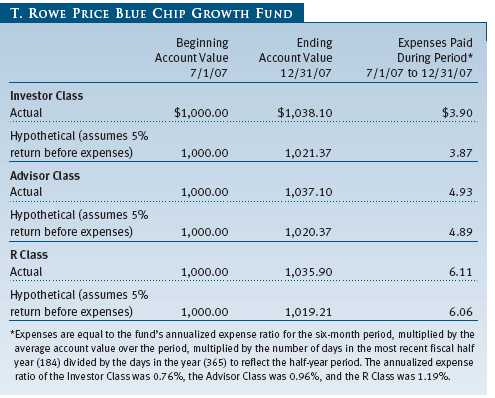
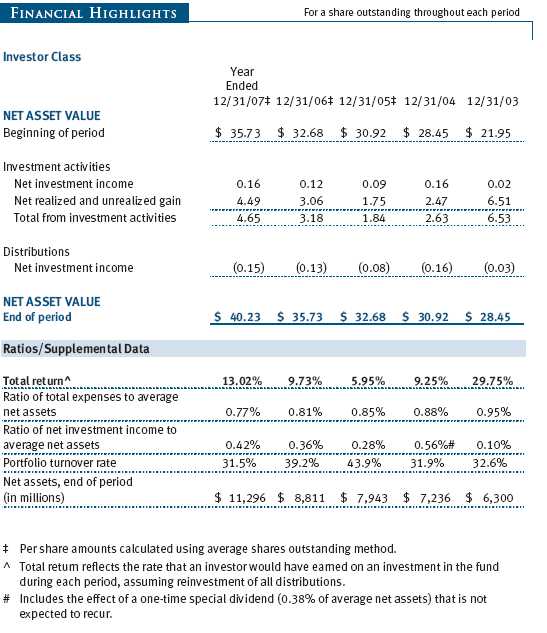
The accompanying notes are an integral part of these financial statements.

The accompanying notes are an integral part of these financial statements.
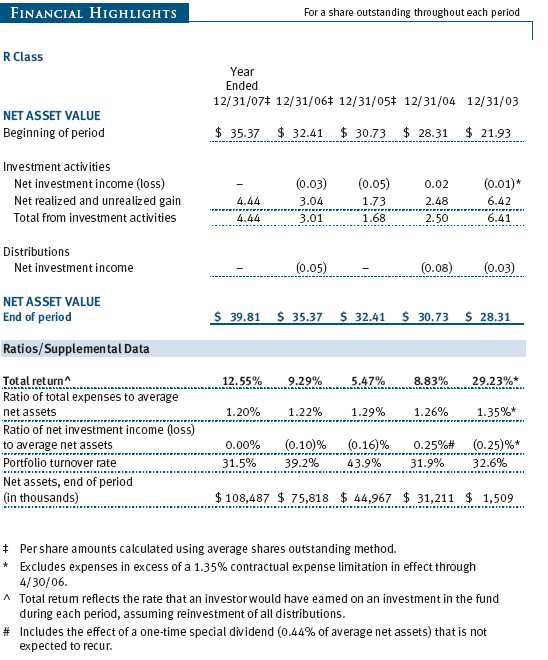
The accompanying notes are an integral part of these financial statements.
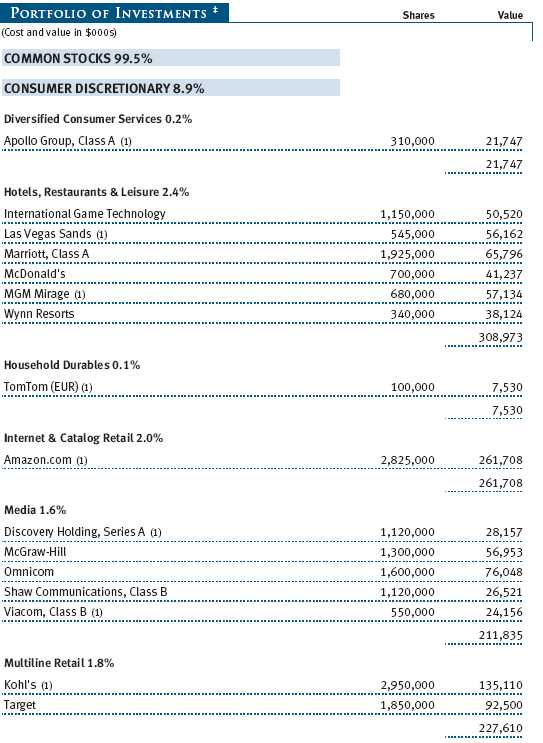
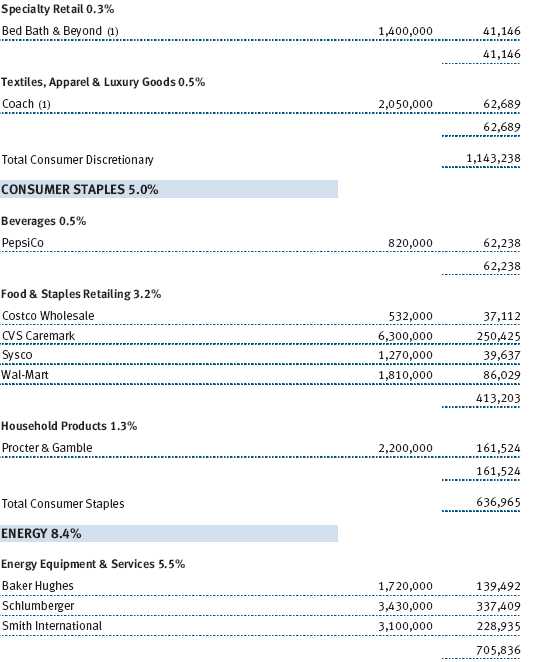
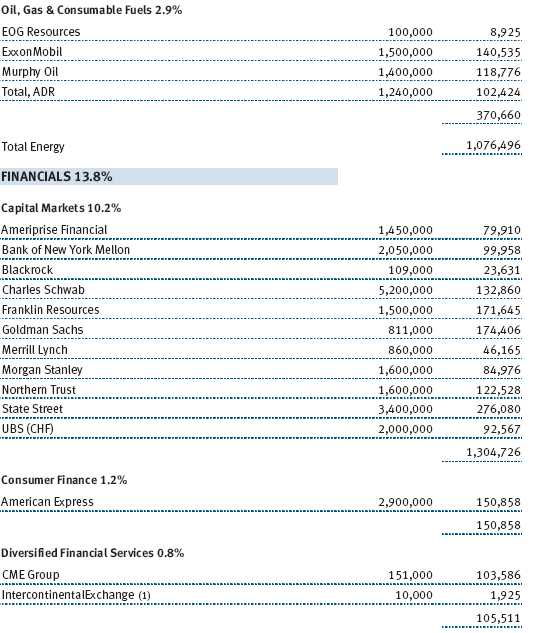
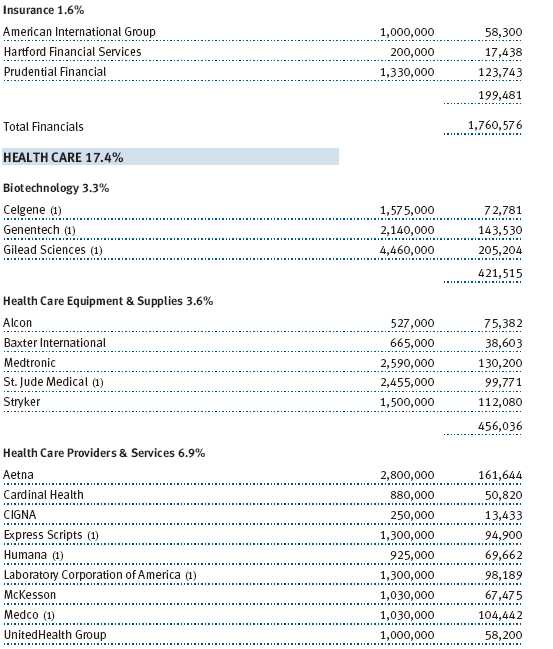
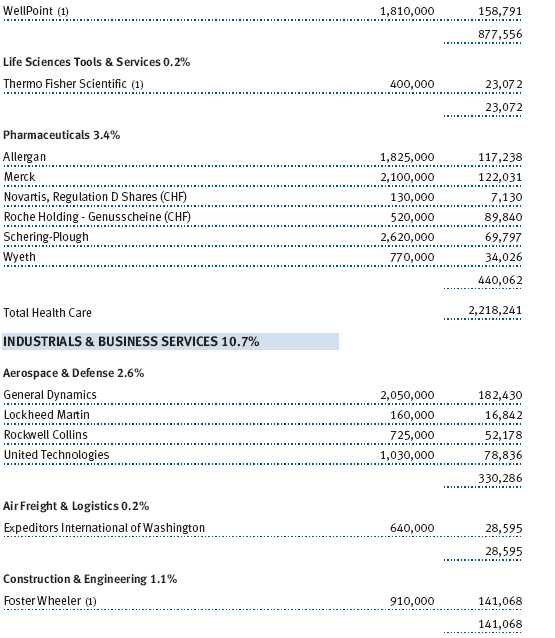
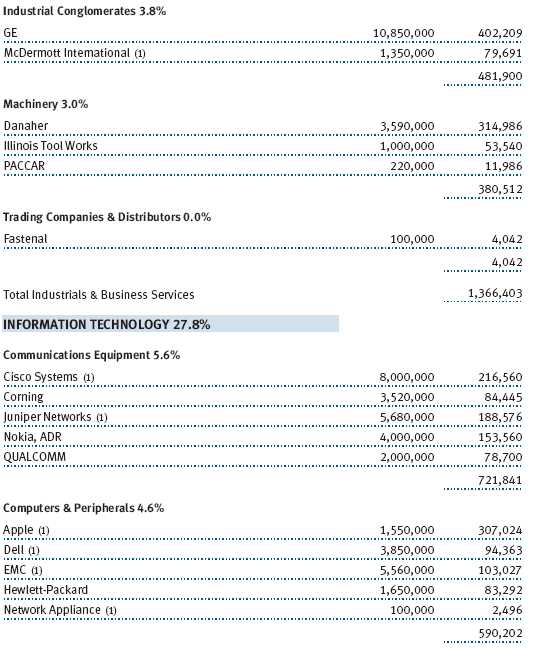
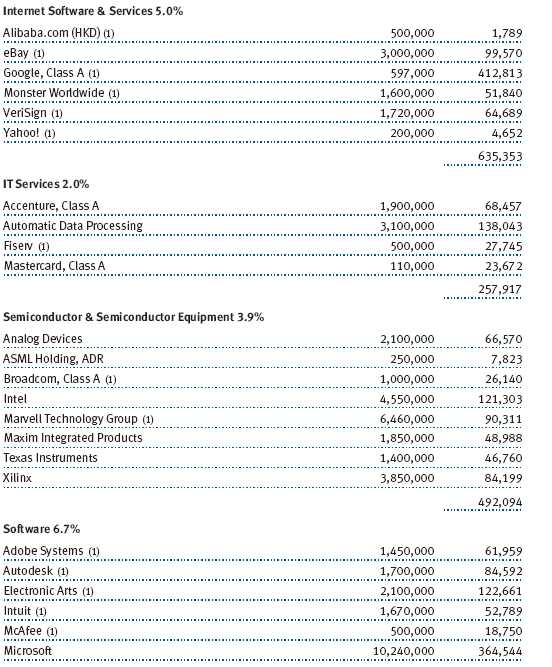
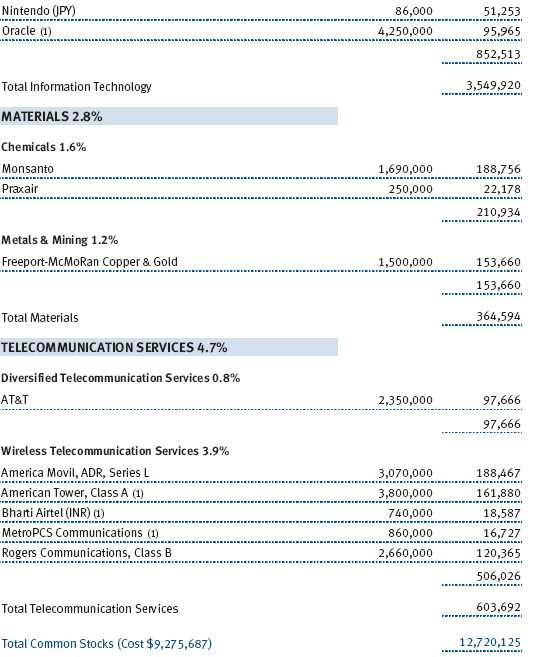

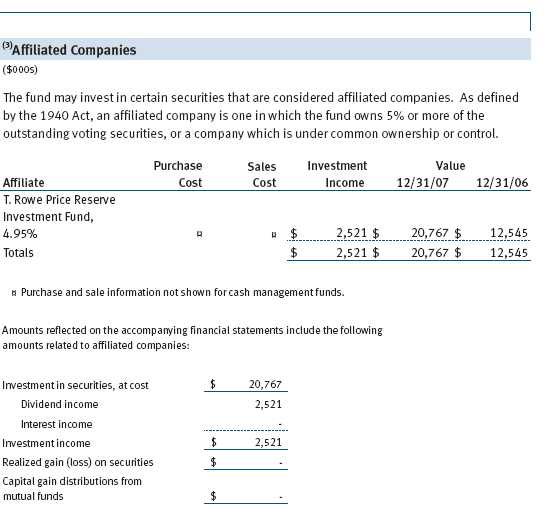
The accompanying notes are an integral part of these financial statements.
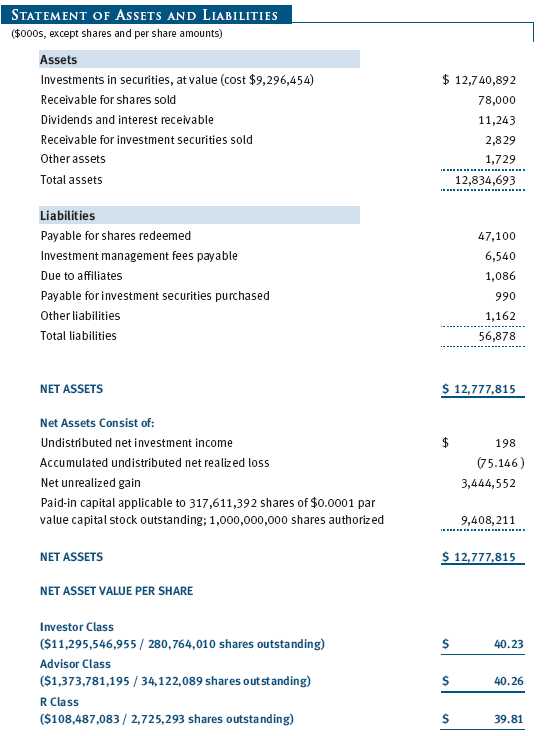
The accompanying notes are an integral part of these financial statements.
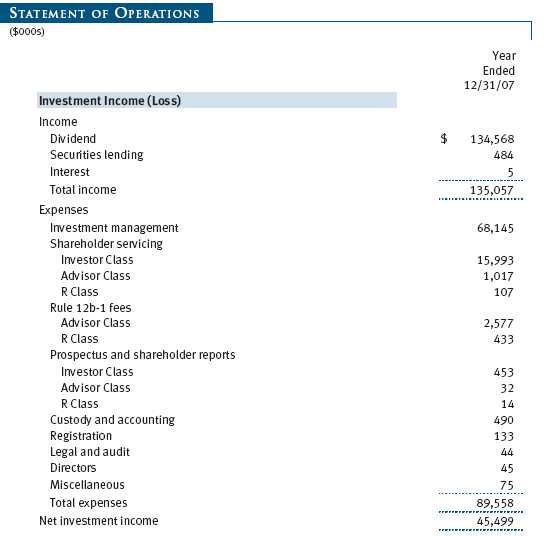
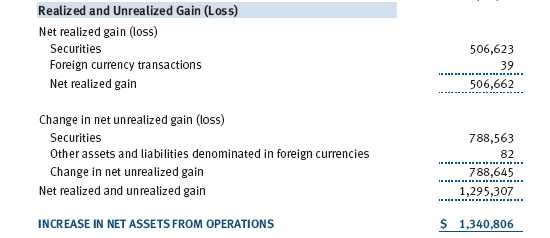
The accompanying notes are an integral part of these financial statements.
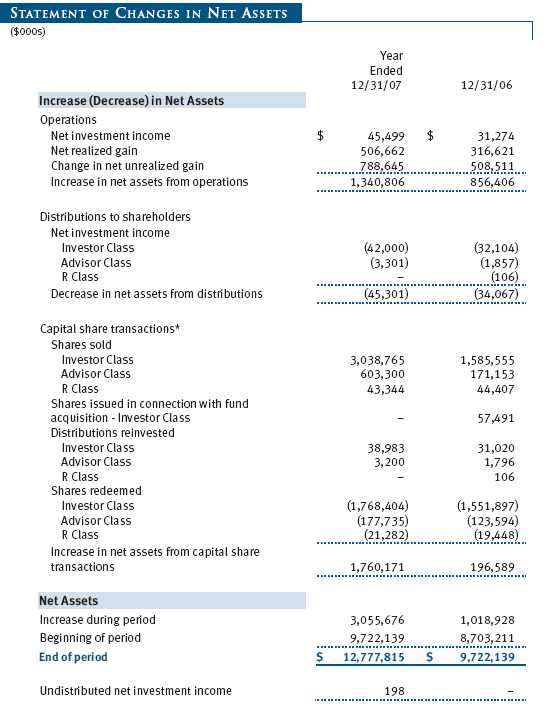
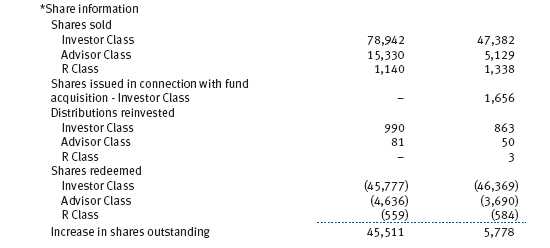
The accompanying notes are an integral part of these financial statements.
| NOTES TO FINANCIAL STATEMENTS |
NOTE 1 - SIGNIFICANT ACCOUNTING POLICIES
T. Rowe Price Blue Chip Growth Fund, Inc. (the fund), is registered under the Investment Company Act of 1940 (the 1940 Act) as a diversified, open-end management investment company. The fund seeks to provide long-term capital growth. Income is a secondary objective. The fund has three classes of shares: the Blue Chip Growth Fund original share class, referred to in this report as the Investor Class, offered since June 30, 1993; the Blue Chip Growth Fund—Advisor Class (Advisor Class), offered since March 31, 2000; and the Blue Chip Growth Fund—R Class (R Class), offered since September 30, 2002. Advisor Class shares are sold only through unaffiliated brokers and other unaffiliated financial intermediaries, and R Class shares are available to retirement plans serviced by intermediaries. The Advisor Class and R Class each operate under separate Board-approved Rule 12b-1 plans, pursuant to which each class compensates financial intermediaries for distribution, shareholder servicing, and/or certain administrative services. Each class has exclusive voting rights on matters related solely to that class, separate voting rights on matters that relate to all classes, and, in all other respects, the same rights and obligations as the other classes.
The accompanying financial statements were prepared in accordance with accounting principles generally accepted in the United States of America, which require the use of estimates made by fund management. Fund management believes that estimates and security valuations are appropriate; however, actual results may differ from those estimates, and the security valuations reflected in the financial statements may differ from the value the fund ultimately realizes upon sale of the securities.
Valuation The fund values its investments and computes its net asset value per share at the close of the New York Stock Exchange (NYSE), normally 4 p.m. ET, each day that the NYSE is open for business. Equity securities listed or regularly traded on a securities exchange or in the over-the-counter (OTC) market are valued at the last quoted sale price or, for certain markets, the official closing price at the time the valuations are made, except for OTC Bulletin Board securities, which are valued at the mean of the latest bid and asked prices. A security that is listed or traded on more than one exchange is valued at the quotation on the exchange determined to be the primary market for such security. Listed securities not traded on a particular day are valued at the mean of the latest bid and asked prices for domestic securities and the last quoted sale price for international securities. Debt securities with original maturities of less than one year are valued at amortized cost in local currency, which approximates fair value when combined with accrued interest.
Investments in mutual funds are valued at the mutual fund’s closing net asset value per share on the day of valuation.
Other investments, including restricted securities, and those for which the above valuation procedures are inappropriate or are deemed not to reflect fair value are stated at fair value as determined in good faith by the T. Rowe Price Valuation Committee, established by the fund’s Board of Directors.
Most foreign markets close before the close of trading on the NYSE. If the fund determines that developments between the close of a foreign market and the close of the NYSE will, in its judgment, materially affect the value of some or all of its portfolio securities, which in turn will affect the fund’s share price, the fund will adjust the previous closing prices to reflect the fair value of the securities as of the close of the NYSE, as determined in good faith by the T. Rowe Price Valuation Committee, established by the fund’s Board of Directors. A fund may also fair value securities in other situations, such as when a particular foreign market is closed but the fund is open. In deciding whether to make fair value adjustments, the fund reviews a variety of factors, including developments in foreign markets, the performance of U.S. securities markets, and the performance of instruments trading in U.S. markets that represent foreign securities and baskets of foreign securities. The fund uses outside pricing services to provide it with closing market prices and information used for adjusting those prices. The fund cannot predict when and how often it will use closing prices and when it will adjust those prices to reflect fair value. As a means of evaluating its fair value process, the fund routinely compares closing market prices, the next day’s opening prices in the same markets, and adjusted prices.
Currency Translation Assets, including investments, and liabilities denominated in foreign currencies are translated into U.S. dollar values each day at the prevailing exchange rate, using the mean of the bid and asked prices of such currencies against U.S. dollars as quoted by a major bank. Purchases and sales of securities, income, and expenses are translated into U.S. dollars at the prevailing exchange rate on the date of the transaction. The effect of changes in foreign currency exchange rates on realized and unrealized security gains and losses is reflected as a component of security gains and losses.
Class Accounting The Advisor Class and R Class each pay distribution, shareholder servicing, and/or certain administrative expenses in the form of Rule 12b-1 fees, in an amount not exceeding 0.25% and 0.50%, respectively, of the class’s average daily net assets. Shareholder servicing, prospectus, and shareholder report expenses incurred by each class are charged directly to the class to which they relate. Expenses common to all classes, investment income, and realized and unrealized gains and losses are allocated to the classes based upon the relative daily net assets of each class.
Rebates Subject to best execution, the fund may direct certain security trades to brokers who have agreed to rebate a portion of the related brokerage commission to the fund in cash. Commission rebates are reflected as realized gain on securities in the accompanying financial statements and totaled $246,000 for the year ended December 31, 2007.
Investment Transactions, Investment Income, and Distributions Income and expenses are recorded on the accrual basis. Premiums and discounts on debt securities are amortized for financial reporting purposes. Dividends received from mutual fund investments are reflected as dividend income; capital gain distributions are reflected as realized gain/loss. Dividend income and capital gain distributions are recorded on the ex-dividend date. Income tax-related interest and penalties, if incurred, would be recorded as income tax expense. Investment transactions are accounted for on the trade date. Realized gains and losses are reported on the identified cost basis. Distributions to shareholders are recorded on the ex-dividend date. Income distributions are declared and paid by each class on an annual basis. Capital gain distributions, if any, are declared and paid by the fund, typically on an annual basis.
New Accounting Pronouncements Effective June 29, 2007, the fund adopted Financial Accounting Standards Board (FASB) Interpretation No. 48 (FIN 48), Accounting for Uncertainty in Income Taxes, a clarification of FASB Statement No. 109, Accounting for Income Taxes. FIN 48 establishes financial accounting and disclosure requirements for recognition and measurement of tax positions taken or expected to be taken on an income tax return. The adoption of FIN 48 had no impact on the fund’s net assets or results of operations.
In September 2006, the FASB released the Statement of Financial Accounting Standard No. 157 (FAS 157), Fair Value Measurements. FAS 157 clarifies the definition of fair value and establishes the framework for measuring fair value, as well as proper disclosure of this methodology in the financial statements. It will be effective for the fund’s fiscal year beginning January 1, 2008. Management is evaluating the effects of FAS 157; however, it is not expected to have a material impact on the fund’s net assets or results of operations.
NOTE 2 - INVESTMENT TRANSACTIONS
Consistent with its investment objective, the fund engages in the following practices to manage exposure to certain risks or to enhance performance. The investment objective, policies, program, and risk factors of the fund are described more fully in the fund’s prospectus and Statement of Additional Information.
Securities Lending The fund lends its securities to approved brokers to earn additional income. It receives as collateral cash and U.S. government securities valued at 102% to 105% of the value of the securities on loan. Cash collateral is invested in a money market pooled trust managed by the fund’s lending agent in accordance with investment guidelines approved by fund management. Collateral is maintained over the life of the loan in an amount not less than the value of loaned securities, as determined at the close of fund business each day; any additional collateral required due to changes in security values is delivered to the fund the next business day. Although risk is mitigated by the collateral, the fund could experience a delay in recovering its securities and a possible loss of income or value if the borrower fails to return the securities. Securities lending revenue recognized by the fund consists of earnings on invested collateral and borrowing fees, net of any rebates to the borrower and compensation to the lending agent. At December 31, 2007, there were no securities on loan.
Other Purchases and sales of portfolio securities, other than short-term securities, aggregated $5,264,617,000 and $3,535,649,000, respectively, for the year ended December 31, 2007.
NOTE 3 - FEDERAL INCOME TAXES
No provision for federal income taxes is required since the fund intends to continue to qualify as a regulated investment company under Subchapter M of the Internal Revenue Code and distribute to shareholders all of its taxable income and gains. Federal income tax regulations differ from generally accepted accounting principles; therefore, distributions determined in accordance with tax regulations may differ significantly in amount or character from net investment income and realized gains for financial reporting purposes. Financial reporting records are adjusted for permanent book/tax differences to reflect tax character. Financial records are not adjusted for temporary differences.
Distributions during the year ended December 31, 2007, were characterized as follows for tax purposes:
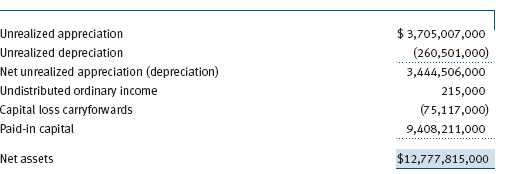
The fund intends to retain realized gains to the extent of available capital loss carryforwards. During the year ended December 31, 2007, the fund utilized $506,573,000 of capital loss carryforwards. As of December 31, 2007, the fund had $75,117,000 of capital loss carryforwards that expire in 2011.
At December 31, 2007, the cost of investments for federal income tax purposes was $9,296,500,000.
NOTE 4 - ACQUISITION
On November 13, 2006, the fund acquired substantially all of the assets of the Bremer Growth Fund (the acquired fund), pursuant to the Agreement and Plan of Reorganization dated September 20, 2006, and approved by shareholders of the acquired fund on November 3, 2006. The acquisition was accomplished by a tax-free exchange of 1,655,855 shares of the fund (with a value of $57,491,000) for all 4,199,664 shares of the acquired fund outstanding on November 10, 2006 with the same value. The net assets of the acquired fund at that date included $12,098,000 of unrealized appreciation. Net assets of the acquired fund were combined with those of the fund, resulting in aggregate net assets of $8,561,973,000 immediately after the acquisition.
NOTE 5 - RELATED PARTY TRANSACTIONS
The fund is managed by T. Rowe Price Associates, Inc. (the manager or Price Associates), a wholly owned subsidiary of T. Rowe Price Group, Inc. The investment management agreement between the fund and the manager provides for an annual investment management fee, which is computed daily and paid monthly. The fee consists of an individual fund fee and a group fee. The individual fund fee is equal to 0.30% of the fund’s average daily net assets up to $15 billion and 0.255% of the fund’s average daily net assets in excess of $15 billion. The group fee rate is calculated based on the combined net assets of certain mutual funds sponsored by Price Associates (the group) applied to a graduated fee schedule, with rates ranging from 0.48% for the first $1 billion of assets to 0.285% for assets in excess of $220 billion. The fund’s group fee is determined by applying the group fee rate to the fund’s average daily net assets. At December 31, 2007, the effective annual group fee ra te was 0.30%.
In addition, the fund has entered into service agreements with Price Associates and two wholly owned subsidiaries of Price Associates (collectively, Price). Price Associates computes the daily share prices and provides certain other administrative services to the fund. T. Rowe Price Services, Inc., provides shareholder and administrative services in its capacity as the fund’s transfer and dividend disbursing agent. T. Rowe Price Retirement Plan Services, Inc., provides subaccounting and recordkeeping services for certain retirement accounts invested in the Investor Class and R Class. For the year ended December 31, 2007, expenses incurred pursuant to these service agreements were $125,000 for Price Associates, $3,854,000 for T. Rowe Price Services, Inc., and $6,618,000 for T. Rowe Price Retirement Plan Services, Inc. The total amount payable at period-end pursuant to these service agreements is reflected as Due to Affiliates in the accompanying financial statements.
Additionally, the fund is one of several mutual funds in which certain college savings plans managed by Price Associates may invest. As approved by the fund’s Board of Directors, shareholder servicing costs associated with each college savings plan are borne by the fund in proportion to the average daily value of its shares owned by the college savings plan. For the year ended December 31, 2007, the fund was charged $999,000 for shareholder servicing costs related to the college savings plans, of which $815,000 was for services provided by Price. The amount payable at period-end pursuant to this agreement is reflected as Due to Affiliates in the accompanying financial statements. At December 31, 2007, approximately 5% of the outstanding shares of the Investor Class were held by college savings plans.
The fund is also one of several mutual funds sponsored by Price Associates (underlying Price funds) in which the T. Rowe Price Spectrum Funds (Spectrum Funds) may invest. The Spectrum Funds do not invest in the underlying Price funds for the purpose of exercising management or control. Pursuant to a special servicing agreement, expenses associated with the operation of the Spectrum Funds are borne by each underlying Price fund to the extent of estimated savings to it and in proportion to the average daily value of its shares owned by the Spectrum Funds. Expenses allocated under this agreement are reflected as shareholder servicing expense in the accompanying financial statements. For the year ended December 31, 2007, the fund was allocated $937,000 of Spectrum Funds’ expenses, of which $611,000 related to services provided by Price. The amount payable at period-end pursuant to this agreement is reflected as Due to Affiliates in the accompanying financial statements. At December 31, 20 07, approximately 6% of the outstanding shares of the Investor Class were held by the Spectrum Funds.
The fund may invest in the T. Rowe Price Reserve Investment Fund and the T. Rowe Price Government Reserve Investment Fund (collectively, the T. Rowe Price Reserve Investment Funds), open-end management investment companies managed by Price Associates and affiliates of the fund. The T. Rowe Price Reserve Investment Funds are offered as cash management options to mutual funds, trusts, and other accounts managed by Price Associates and/or its affiliates, and are not available for direct purchase by members of the public. The T. Rowe Price Reserve Investment Funds pay no investment management fees.
NOTE 6 - INTERFUND BORROWING PROGRAM
Pursuant to its prospectus, the fund may borrow up to 33 1/3% of its total assets. The manager has developed a program that provides temporary liquidity under an interfund borrowing agreement between the fund and other T. Rowe Price-sponsored mutual funds and permits the borrowing and lending of cash at rates beneficial to both the borrowing and lending funds. Pursuant to program guidelines, loans totaling 10% or more of a borrowing fund’s total assets are collateralized at 102% of the value of the loan; loans of less than 10% are unsecured. During the year ended December 31, 2007, the fund incurred $16,000 in interest expense related to outstanding borrowings on 16 days, in the average amount of $6,688,000, and at an average annual rate of 5.46%. At December 31, 2007, there were no borrowings outstanding.
| REPORT OF INDEPENDENT REGISTERED PUBLIC ACCOUNTING FIRM |
To the Board of Directors and Shareholders of
T. Rowe Price Blue Chip Growth Fund, Inc.
In our opinion, the accompanying statement of assets and liabilities, including the portfolio of investments, and the related statements of operations and of changes in net assets and the financial highlights present fairly, in all material respects, the financial position of T. Rowe Price Blue Chip Growth Fund, Inc. (the “Fund”) at December 31, 2007, the results of its operations for the year then ended, the changes in its net assets for each of the two years in the period then ended and the financial highlights for each of the five years in the period then ended, in conformity with accounting principles generally accepted in the United States of America. These financial statements and financial highlights (hereafter referred to as “financial statements”) are the responsibility of the Fund’s management; our responsibility is to express an opinion on these financial statements based on our audits. We conducted our audits of these financial statements in accordance with the auditing standards of the Public Company Accounting Oversight Board (United States). Those standards require that we plan and perform the audit to obtain reasonable assurance about whether the financial statements are free of material misstatement. An audit includes examining, on a test basis, evidence supporting the amounts and disclosures in the financial statements, assessing the accounting principles used and significant estimates made by management, and evaluating the overall financial statement presentation. We believe that our audits, which included confirmation of securities at December 31, 2007, by correspondence with the custodian and by agreement to the underlying ownership record for T. Rowe Price Reserve Investment Fund, provide a reasonable basis for our opinion.
PricewaterhouseCoopers LLP
Baltimore, Maryland
February 12, 2008
| TAX INFORMATION (UNAUDITED) FOR THE TAX YEAR ENDED 12/31/07 |
We are providing this information as required by the Internal Revenue Code. The amounts shown may differ from those elsewhere in this report because of differences between tax and financial reporting requirements.
For taxable non-corporate shareholders, $45,516,000 of the fund’s income represents qualified dividend income subject to the 15% rate category.
For corporate shareholders, $45,516,000 of the fund’s income qualifies for the dividends-received deduction.
| INFORMATION ON PROXY VOTING POLICIES, PROCEDURES, AND RECORDS |
A description of the policies and procedures used by T. Rowe Price funds and portfolios to determine how to vote proxies relating to portfolio securities is available in each fund’s Statement of Additional Information, which you may request by calling 1-800-225-5132 or by accessing the SEC’s Web site, www.sec.gov. The description of our proxy voting policies and procedures is also available on our Web site, www.troweprice.com. To access it, click on the words “Company Info” at the top of our homepage for individual investors. Then, in the window that appears, click on the “Proxy Voting Policy” navigation button in the top left corner.
Each fund’s most recent annual proxy voting record is available on our Web site and through the SEC’s Web site. To access it through our Web site, follow the directions above, then click on the words “Proxy Voting Record” at the bottom of the Proxy Voting Policy page.
| HOW TO OBTAIN QUARTERLY PORTFOLIO HOLDINGS |
The fund files a complete schedule of portfolio holdings with the Securities and Exchange Commission for the first and third quarters of each fiscal year on Form N-Q. The fund’s Form N-Q is available electronically on the SEC’s Web site (www.sec.gov); hard copies may be reviewed and copied at the SEC’s Public Reference Room, 450 Fifth St. N.W., Washington, DC 20549. For more information on the Public Reference Room, call 1-800-SEC-0330.
| ABOUT THE FUND’S DIRECTORS AND OFFICERS |
Your fund is governed by a Board of Directors (Board) that meets regularly to review a wide variety of matters affecting the fund, including performance, investment programs, compliance matters, advisory fees and expenses, service providers, and other business affairs. The Board elects the fund’s officers, who are listed in the final table. At least 75% of Board members are independent of T. Rowe Price Associates, Inc. (T. Rowe Price), and T. Rowe Price International, Inc. (T. Rowe Price International); “inside” or “interested” directors are employees or officers of T. Rowe Price. The business address of each director and officer is 100 East Pratt Street, Baltimore, Maryland 21202. The Statement of Additional Information includes additional information about the directors and is available without charge by calling a T. Rowe Price representative at 1-800-225-5132.
| Independent Directors | |
| Name | |
| (Year of Birth) | Principal Occupation(s) During Past 5 Years and Directorships of |
| Year Elected* | Other Public Companies |
| Jeremiah E. Casey | Director, National Life Insurance (2001 to 2005); Director, The Rouse |
| (1940) | Company, real estate developers (1990 to 2004); Director, Allfirst |
| 2005 | Financial Inc. (previously First Maryland Bancorp) (1983 to 2002) |
| Anthony W. Deering | Chairman, Exeter Capital, LLC, a private investment firm (2004 to pres- |
| (1945) | ent); Director, Vornado Real Estate Investment Trust (3/04 to present); |
| 2001 | Member, Advisory Board, Deutsche Bank North America (2004 to pres- |
| ent); Director, Chairman of the Board, and Chief Executive Officer, The | |
| Rouse Company, real estate developers (1997 to 2004) | |
| Donald W. Dick, Jr. | Principal, EuroCapital Advisors, LLC, an acquisition and management |
| (1943) | advisory firm; Chairman, The Haven Group, a custom manufacturer of |
| 1993 | modular homes (1/04 to present) |
| David K. Fagin | Chairman and President, Nye Corporation (6/88 to present); Chairman, |
| (1938) | Canyon Resources Corp. (8/07 to present); Director, Golden Star |
| 1993 | Resources Ltd. (5/92 to present); Director, Pacific Rim Mining Corp. |
| (2/02 to present) | |
| Karen N. Horn | Director, Federal National Mortgage Association (9/06 to present); |
| (1943) | Managing Director and President, Global Private Client Services, Marsh |
| 2003 | Inc. (1999 to 2003); Director, Georgia Pacific (5/04 to 12/05), Eli Lilly |
| and Company, and Simon Property Group | |
| Theo C. Rodgers | President, A&R Development Corporation (1977 to present) |
| (1941) | |
| 2005 | |
| John G. Schreiber | Owner/President, Centaur Capital Partners, Inc., a real estate invest- |
| (1946) | ment company; Partner, Blackstone Real Estate Advisors, L.P. |
| 2001 |
| *Each independent director oversees 121 T. Rowe Price portfolios and serves until retirement, resignation, or |
| election of a successor. |
| Inside Directors | |
| Name | |
| (Year of Birth) | |
| Year Elected* | |
| [Number of T. Rowe Price | Principal Occupation(s) During Past 5 Years and Directorships of |
| Portfolios Overseen] | Other Public Companies |
| Edward C. Bernard | Director and Vice President, T. Rowe Price; Vice Chairman of the Board, |
| (1956) | Director, and Vice President, T. Rowe Price Group, Inc.; Chairman of the |
| 2006 | Board, Director, and President, T. Rowe Price Investment Services, Inc.; |
| [121] | Chairman of the Board and Director, T. Rowe Price Global Asset |
| Management Limited, T. Rowe Price Global Investment Services | |
| Limited, T. Rowe Price Retirement Plan Services, Inc., T. Rowe Price | |
| Savings Bank, and T. Rowe Price Services, Inc.; Director, T. Rowe Price | |
| International, Inc.; Chief Executive Officer, Chairman of the Board, | |
| Director, and President, T. Rowe Price Trust Company; Chairman of the | |
| Board, all funds | |
| Brian C. Rogers, CFA, CIC | Chief Investment Officer, Director, and Vice President, T. Rowe Price; |
| (1955) | Chairman of the Board, Chief Investment Officer, Director, and Vice |
| 2006 | President, T. Rowe Price Group, Inc.; Vice President, T. Rowe Price |
| [68] | Trust Company |
| *Each inside director serves until retirement, resignation, or election of a successor. |
| Officers | |
| Name (Year of Birth) | |
| Title and Fund(s) Served | Principal Occupation(s) |
| P. Robert Bartolo, CPA (1972) | Vice President, T. Rowe Price and T. Rowe Price |
| Vice President, Blue Chip Growth Fund | Group, Inc. |
| Peter J. Bates, CFA (1974) | Vice President, T. Rowe Price and T. Rowe Price |
| Vice President, Blue Chip Growth Fund | Group, Inc.; formerly intern, T. Rowe Price (to |
| 2004); Vice President of Finance, Rent-A-Center, | |
| Inc. (to 2003) | |
| Joseph A. Carrier, CPA (1960) | Vice President, T. Rowe Price, T. Rowe Price |
| Treasurer, Blue Chip Growth Fund | Group, Inc., T. Rowe Price Investment Services, |
| Inc., and T. Rowe Price Trust Company | |
| Henry M. Ellenbogen (1971) | Vice President, T. Rowe Price and T. Rowe Price |
| Vice President, Blue Chip Growth Fund | Group, Inc. |
| Roger L. Fiery III, CPA (1959) | Vice President, T. Rowe Price, T. Rowe Price |
| Vice President, Blue Chip Growth Fund | Group, Inc., T. Rowe Price International, Inc., |
| and T. Rowe Price Trust Company | |
| John R. Gilner (1961) | Chief Compliance Officer and Vice President, |
| Chief Compliance Officer, | T. Rowe Price; Vice President, T. Rowe Price |
| Blue Chip Growth Fund | Group, Inc., and T. Rowe Price Investment |
| Services, Inc. | |
| Gregory S. Golczewski (1966) | Vice President, T. Rowe Price and T. Rowe Price |
| Vice President, Blue Chip Growth Fund | Trust Company |
| Henry H. Hopkins (1942) | Director and Vice President, T. Rowe Price |
| Vice President, Blue Chip Growth Fund | Investment Services, Inc., T. Rowe Price Services, |
| Inc., and T. Rowe Price Trust Company; Vice | |
| President, T. Rowe Price, T. Rowe Price Group, | |
| Inc., T. Rowe Price International, Inc., and | |
| T. Rowe Price Retirement Plan Services, Inc. | |
| Thomas J. Huber, CFA (1966) | Vice President, T. Rowe Price, T. Rowe Price |
| Vice President, Blue Chip Growth Fund | Group, Inc., and T. Rowe Price Trust Company |
| Kris H. Jenner, M.D., D. Phil. (1962) | Vice President, T. Rowe Price and T. Rowe Price |
| Vice President, Blue Chip Growth Fund | Group, Inc. |
| Patricia B. Lippert (1953) | Assistant Vice President, T. Rowe Price and |
| Secretary, Blue Chip Growth Fund | T. Rowe Price Investment Services, Inc. |
| Jason Nogueira, CFA (1974) | Vice President, T. Rowe Price and T. Rowe Price |
| Vice President, Blue Chip Growth Fund | Group, Inc.; formerly Healthcare Equity Analyst, |
| Putnam Investments (to 2004); student, | |
| Harvard Business School (to 2003) | |
| Timothy E. Parker (1974) | Vice President, T. Rowe Price and T. Rowe Price |
| Vice President, Blue Chip Growth Fund | Group, Inc. |
| Larry J. Puglia, CFA, CPA (1960) | Vice President, T. Rowe Price, T. Rowe Price |
| President, Blue Chip Growth Fund | Group, Inc., and T. Rowe Price Trust Company |
| Karen M. Regan (1967) | Vice President, T. Rowe Price |
| Vice President, Blue Chip Growth Fund | |
| Robert W. Sharps, CFA, CPA (1971) | Vice President, T. Rowe Price and T. Rowe Price |
| Vice President, Blue Chip Growth Fund | Group, Inc. |
| Robert W. Smith (1961) | Vice President, T. Rowe Price, T. Rowe Price |
| Vice President, Blue Chip Growth Fund | Group, Inc., and T. Rowe Price Trust Company |
| Joshua K. Spencer, CFA (1973) | Vice President, T. Rowe Price and T. Rowe Price |
| Vice President, Blue Chip Growth Fund | Group, Inc.; formerly Research Analyst and |
| Sector Fund Portfolio Manager, Fidelity | |
| Investments (to 2004) | |
| Julie L. Waples (1970) | Vice President, T. Rowe Price |
| Vice President, Blue Chip Growth Fund | |
| Unless otherwise noted, officers have been employees of T. Rowe Price or T. Rowe Price International for at least |
| five years. |
Item 2. Code of Ethics.
The registrant has adopted a code of ethics, as defined in Item 2 of Form N-CSR, applicable to its principal executive officer, principal financial officer, principal accounting officer or controller, or persons performing similar functions. A copy of this code of ethics is filed as an exhibit to this Form N-CSR. No substantive amendments were approved or waivers were granted to this code of ethics during the period covered by this report.
Item 3. Audit Committee Financial Expert.
The registrant’s Board of Directors/Trustees has determined that Ms. Karen N. Horn qualifies as an audit committee financial expert, as defined in Item 3 of Form N-CSR. Ms. Horn is considered independent for purposes of Item 3 of Form N-CSR.
Item 4. Principal Accountant Fees and Services.
(a) – (d) Aggregate fees billed to the registrant for the last two fiscal years for professional services rendered by the registrant’s principal accountant were as follows:

Audit fees include amounts related to the audit of the registrant’s annual financial statements and services normally provided by the accountant in connection with statutory and regulatory filings. Audit-related fees include amounts reasonably related to the performance of the audit of the registrant’s financial statements and specifically include the issuance of a report on internal controls and, if applicable, agreed-upon procedures related to fund acquisitions. Tax fees include amounts related to services for tax compliance, tax planning, and tax advice. The nature of these services specifically includes the review of distribution calculations and the preparation of Federal, state, and excise tax returns. All other fees include the registrant’s pro-rata share of amounts for agreed-upon procedures in conjunction with service contract approvals by the registrant’s Board of Directors/Trustees.
(e)(1) The registrant’s audit committee has adopted a policy whereby audit and non-audit services performed by the registrant’s principal accountant for the registrant, its investment adviser, and any entity controlling, controlled by, or under common control with the investment adviser that provides ongoing services to the registrant require pre-approval in advance at regularly scheduled audit committee meetings. If such a service is required between regularly scheduled audit committee meetings, pre-approval may be authorized by one audit committee member with ratification at the next scheduled audit committee meeting. Waiver of pre-approval for audit or non-audit services requiring fees of a de minimis amount is not permitted.
(2) No services included in (b) – (d) above were approved pursuant to paragraph (c)(7)(i)(C) of Rule 2-01 of Regulation S-X.
(f) Less than 50 percent of the hours expended on the principal accountant’s engagement to audit the registrant’s financial statements for the most recent fiscal year were attributed to work performed by persons other than the principal accountant’s full-time, permanent employees.
(g) The aggregate fees billed for the most recent fiscal year and the preceding fiscal year by the registrant’s principal accountant for non-audit services rendered to the registrant, its investment adviser, and any entity controlling, controlled by, or under common control with the investment adviser that provides ongoing services to the registrant were $1,486,000 and $1,401,000, respectively, and were less than the aggregate fees billed for those same periods by the registrant’s principal accountant for audit services rendered to the T. Rowe Price Funds.
(h) All non-audit services rendered in (g) above were pre-approved by the registrant’s audit committee. Accordingly, these services were considered by the registrant’s audit committee in maintaining the principal accountant’s independence.
Item 5. Audit Committee of Listed Registrants.
Not applicable.
Item 6. Schedule of Investments.
Not applicable. The complete schedule of investments is included in Item 1 of this Form N-CSR.
Item 7. Disclosure of Proxy Voting Policies and Procedures for Closed-End Management Investment Companies.
Not applicable.
Item 8. Portfolio Managers of Closed-End Management Investment Companies.
Not applicable.
Item 9. Purchases of Equity Securities by Closed-End Management Investment Company and Affiliated Purchasers.
Not applicable.
Item 10. Submission of Matters to a Vote of Security Holders.
Not applicable.
Item 11. Controls and Procedures.
(a) The registrant’s principal executive officer and principal financial officer have evaluated the registrant’s disclosure controls and procedures within 90 days of this filing and have concluded that the registrant’s disclosure controls and procedures were effective, as of that date, in ensuring that information required to be disclosed by the registrant in this Form N-CSR was recorded, processed, summarized, and reported timely.
(b) The registrant’s principal executive officer and principal financial officer are aware of no change in the registrant’s internal control over financial reporting that occurred during the registrant’s second fiscal quarter covered by this report that has materially affected, or is reasonably likely to materially affect, the registrant’s internal control over financial reporting.
Item 12. Exhibits.
(a)(1) The registrant’s code of ethics pursuant to Item 2 of Form N-CSR is attached.
(2) Separate certifications by the registrant's principal executive officer and principal financial officer, pursuant to Section 302 of the Sarbanes-Oxley Act of 2002 and required by Rule 30a-2(a) under the Investment Company Act of 1940, are attached.
(3) Written solicitation to repurchase securities issued by closed-end companies: not applicable.
(b) A certification by the registrant's principal executive officer and principal financial officer, pursuant to Section 906 of the Sarbanes-Oxley Act of 2002 and required by Rule 30a-2(b) under the Investment Company Act of 1940, is attached.
SIGNATURES | |
| Pursuant to the requirements of the Securities Exchange Act of 1934 and the Investment | |
| Company Act of 1940, the registrant has duly caused this report to be signed on its behalf by the | |
| undersigned, thereunto duly authorized. | |
| T. Rowe Price Blue Chip Growth Fund, Inc. | |
| By | /s/ Edward C. Bernard |
| Edward C. Bernard | |
| Principal Executive Officer | |
| Date | February 19, 2008 |
| Pursuant to the requirements of the Securities Exchange Act of 1934 and the Investment | |
| Company Act of 1940, this report has been signed below by the following persons on behalf of | |
| the registrant and in the capacities and on the dates indicated. | |
| By | /s/ Edward C. Bernard |
| Edward C. Bernard | |
| Principal Executive Officer | |
| Date | February 19, 2008 |
| By | /s/ Joseph A. Carrier |
| Joseph A. Carrier | |
| Principal Financial Officer | |
| Date | February 19, 2008 |